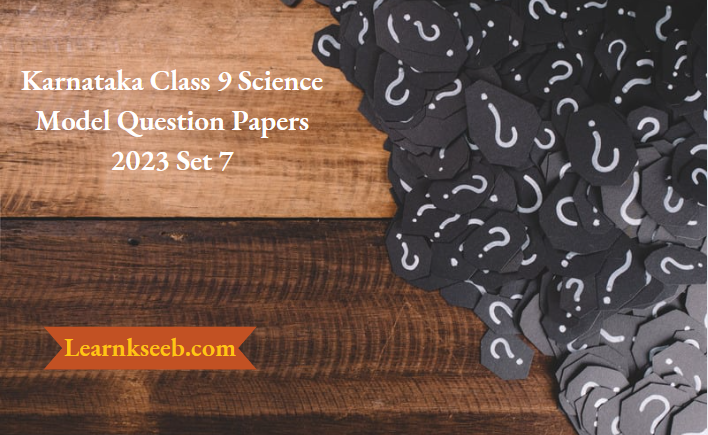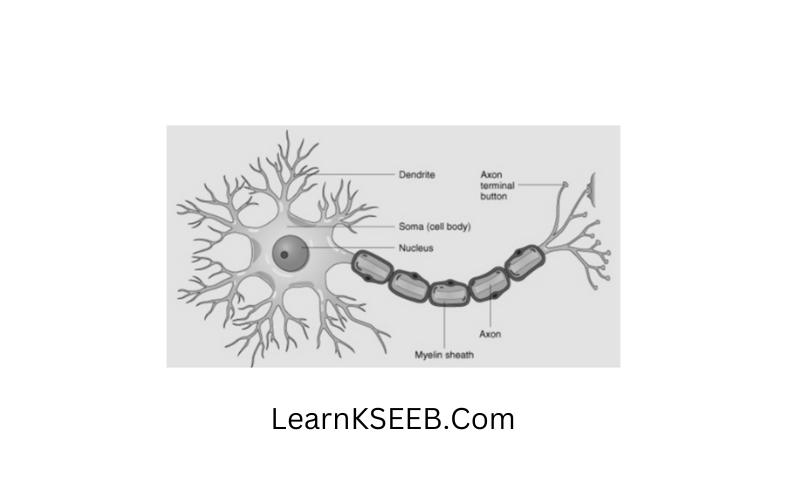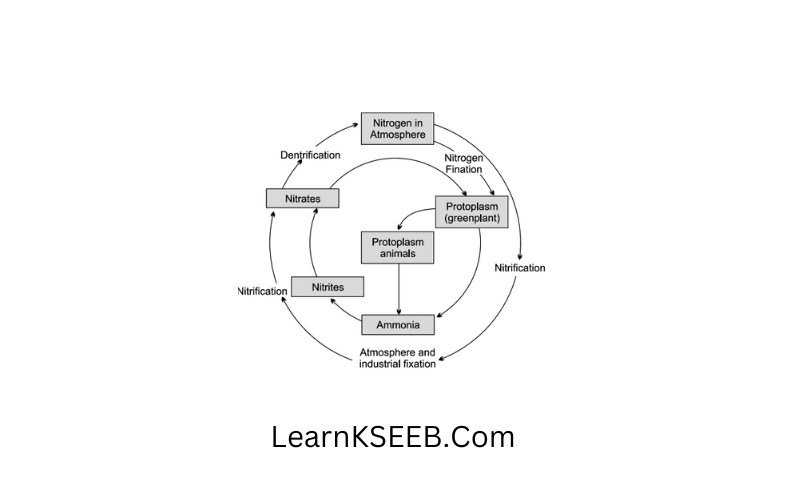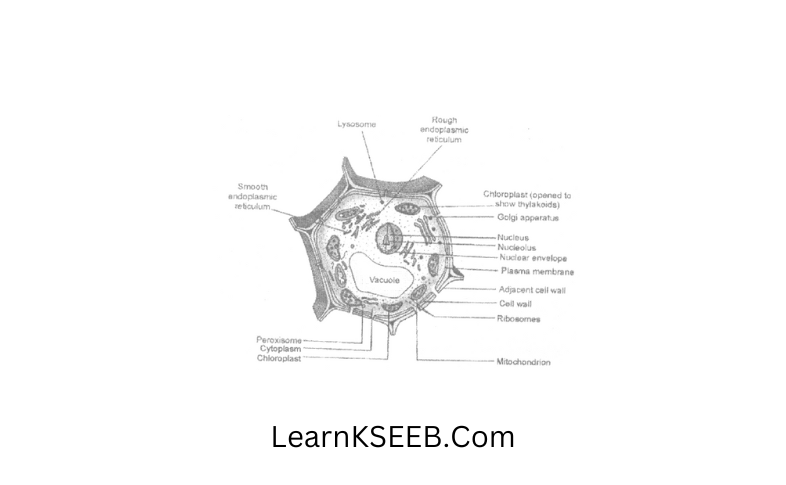Karnataka Class 9 Science Model Question Papers 2023 Set 7
Choose The Correct Alternative And Write The Complete Answer Along With Its Alphabet In The Sheet Provided:
Question 1. Dry ice is
- The ice has no water for crystallisation
- Ice that has been dried
- Solid carbon dioxide
- None of these
Answer: 3. Solid carbon dioxide
Question 2. On passing through a colloidal solution, the beam of light gets
- Reflected
- Refracted
- Scattered
- Absorbed
Answer: 3.
Question 3.Which of the following is not present in prokaryotes
- Ribosomes
- Cell wall
- Plasma membrane
- Nuclear membrane
Answer: 4. Nuclear membrane
Karnataka 9th Standard Science Model Paper 2023 Set 7 Free PDF with Answer Key
Question 4. The cycling of elements in an ecosystem is called
- Chemical cycle
- Geochemical cycle
- Biogeochemical cycle
- Geological cycle
Answer: 3. Biogeochemical cycle

Question 5. Tobacco smoke contains carbon monoxide which
- Reduces the oxygen-carrying capacity of the blood
- Causes gastric ulcers
- Raises blood pressure
- Is carcinogenic
Answer: 1. Reduces the oxygen-carrying capacity of the blood
Class 9 Science Model Papers Karnataka Set 7
Question 6. A sound wave cannot propagate in
- Air
- Water
- Vacuum
- Metals
Answer: 3. Vaccum
Class 9 Karnataka Science Model Paper 2023 Set 7 Solved Questions PDF
Question 7. The unit of work is
- Joule
- Newton
- kg m/s
- dyne
Answer: 1. Joule
Question 8. The rate of change of momentum is known as
- Work
- Force
- Impulse
- Energy
Answer: 2. Force
Question 9. When a body covers unequal distances in equal intervals of time, it is said to be in
- Linear motion
- Uniform motion
- Non-uniform motion
- Vibratory motion
Answer: 3. Non-uniform motion
Question 10. The formulae of Aluminium chloride is
- Al2Cl3
- AlCl3
- AICI
- Al3Cl
Answer: 2. AlCl3
Match The Following:
A B
The simple tissue Root apex
Apical meristem nodes
lateral meristem parenchyma
Intercalary meristem cambium
xylem
Answer:
A B
The simple tissue parenchyma
Apical meristem Root apex
lateral meristem cambium
Intercalary meristem nodes
Answer the following:
Question 1. Define the following
- Melting point
- Latent heat of fusion
Answer:
- Melting point: The temperature at which solid melts to become a liquid at the atmospheric pressure is called the melting point.
- Latent heat of fusion: The amount of heat energy that is required to change 1kg of a solid into liquid at atmospheric pressure at its melting point is known as the latent heat of fusion.
Question 2. Why does our palm feel cold when we put some acetone or petrol or perfume on it?
Answer: The particles gain energy from our palm or surroundings and evaporate causing the palm to feel cool.
Question 3. What is chromatography? Mention any two applications of it.
Answer: chromatography is the technique used for the separation of those solutes that dissolve in the same solvent.
Application:
- To separate colours in a dye
- To separate pigments from natural colours
Karnataka Board 9th Science Model Paper 2023 Set 7 Latest Exam Pattern PDF
Question 4. To make a saturated solution, 36g of sodium chloride is dissolved in 100g of water at 293k. Find its concentration at this temperature.
Answer:
mass of so lute (sodium chloride) 36g
mass of solvent (water) = 100g
mass of solution=mass of solute + mass of solvent
= 36g+ 100g
= 136g
mass percentage of solution
\(=\frac{36}{136} \times 100\)
= 26.47%
Question 5. Write down the names of compounds represented by the following formulae
- Al2(SO4)3
- CaCl2
- K2SO4
- CaCO3
Answer:
- Aluminium sulphate
- Calcium chloride
- Potassium sulphate
- Calcium carbonate
Question 6. The cell is called the structural and functional unit of life why?
Answer:
- All living organisms are made up of cells.
- All the life processes such as respiration, digestion, excretion etc., take place in a cell or a single-cell organism.
Question 7. What are the functions of areolar tissue?
Answer:
- It fills the space inside the organs and supports internal organs.
- Helps in the repair of tissues.
Question 8. Name the following
- Tissue forms the inner lining of our mouth.
- Tissue that stores fat in our body.
Answer:
- Squamous epithelial
- Adipose tissue
Question 9. What are the features that all chordates possess?
Answer:
- They have a notochord
- They are coelomate
- They are triploblastic
- They have paired gill pouches
Question 10. List the differences between Amphibians and Reptiles.
Answer:
Amphibians:
- Found both in water & on land
- Breathe either through the gills or lungs.
- smooth skin with mucus
Reptiles:
- Found on land
- Breathe through the lungs only
- Rough dry skin with scale.
Question 11. An object has moved through a distance can it have zero displacements? If yes, support your answer with an example.
Answer: Yes, for example, if Ramu goes to market from home and then comes back home, then his displacement is zero but the distance travelled is not zero.
Question 12. Calculate the force required to change the velocity of an object of mass 8kg from 4ms-1 to 6ms-1 in 2 seconds.
Answer:
Data:
u = 4ms-1
v = 6ms1
t = 2 seconds
m = 8kg
\(-\frac{6-4}{2}=\frac{2}{2}=1 \mathrm{~ms}^{-2}\)
∴ Force F = m x a
= 8×1
F= 8 newton
9th Standard Karnataka Science Sample Paper 2023 Set 7 Important Questions PDF
Question 13. What is an echo? Mention the condition for the echo to be heard.
Answer: The sound heard after reflection from a rigid surface is called an echo.
condition:
- The time interval between the original sound and the reflected sound must be lesser or equal to 0.1 sec
- The reflecting surface should be at a minimum distance of 17m from the listener.
Question 14.Define the following
- Wavelength of sound
- The amplitude of a sound.
Answer:
- The distance between two successive compressions or rarefactions is the wavelength of sound.
- The highest displacement of a vibrating particle from its resting position is the amplitude of the sound.
Question 15.
- When do we say that the work is done?
- Define 1 J of work.
Answer:
- A force acts on a body. The body is displaced by the force
- when 1 Newton force displaces a body by 1m in the direction of applied force the 1 joule of work is said to be done.
Question 16. A girl pulls a bucket of water of total mass 5 kg from a well which is 10m deep in 10 sec, calculate the power used by her. (g = 10 m/s2)
Answer:
Data:
m = 5kg
h = 10m
t = 10 sec
g = 10m/s2
w = mgh
= 5 x 10 x 10
W = 500J
P = 50 watt
Question 17. Which of the following has more inertia?
- A rubber ball and a stone of the same size?
- A bicycle and train?
Answer:
- A stone of the same size has more mass than that a rubber ball, therefore, the stone has more inertia.
- A train has much more mass than a bicycle therefore a train has more inertia.
Question 18.
- What is immunisation?
- What are the immunisation programmes available at the nearest health centre in your locality?
Answer:
- The practice of providing immunity to the body by giving vaccines is called immunisation,
- The Administration of polio drops to children under the age of 5 years. Vaccines for measles, smallpox & Hepatitis.
Question 19. What are the methods of preventing or reducing soil erosion?
Answer:
- Reforestation or planting of trees.
- Check to overgraze
- Improved methods of farming in agriculture.
Question 20. Mention any four activity that pollutes the water resources.
Answer:
- Pollutants from industries.
- Agricultural wastes like fertilizers & pesticides
- sewage water.
- Thermal water from certain industries.
Question 21. For increasing production, what is common in poultry, fisheries and beekeeping?
Answer:
- Use local and imported varieties of the breeds.
- It involves low investment in fanning.
Question 22. State the difference between manure and fertilizer
Answer:
Manure:
- It consists of organic matter
- prepared from animal excreta and plant waste
- Its use causes no pollution
Fertilizer:
- It consists of inorganic matter.
- It is prepared commercially from chemicals.
- It causes pollution in soil and water
Question 23. How many electrons, protons and neutrons will be there in an element \({ }_9^{19} \mathrm{X}\)? What will be the valency of the element?
Answer:
Atomic number = 9
mass number = 19
No. of electrons = 9
Number of protons = 9
Number of neutrons = mass number – atomic
number
= 19-9
n= 10
electronic configuration of X = 2,7
valency of X= -1 (∵ it receives one electron)
Question 24. Calculate the number of moles in 17gm of H2O2.
Answer:
1 mole of H2O2= 2 x 1 + 2 x16
= 2 + 32
= 34 gm
34gm of H2O2 = 1 mole
17gm of H2O2 = \(\frac{1}{34} \times 17\)
=\(\frac{1}{2}\)
= 0.5moles
Answer The Following:
Question 1. Draw a labelled diagram of a neuron.
Answer:

Question 2. State three features of the nuclear model of an atom put forward by Rutherford.
Answer:
- There is a positively charged centre in an atom called the nucleus. Nearly all the mass of an atom resides in the nucleus.
- The electrons revolve around the nucleus in circular paths.
- The size of the nucleus is very small compared to the size of the atom.
Question 3. What are the characteristics of the particles of matter?
Answer:
- Particles of matter are very small
- Particles have space between them
- Particles attract each other
- Particles are continuously moving.
Karnataka State Board Class 9 Science Model Paper 2023 Set 7 with Step-by-Step Solutions
Question 4. Draw the diagram of the nitrogen cycle in nature
Answer:

Answer The Following:
Question 1. Differentiate between prokaryotic cells and Eukaryotic cell
Answer:
Prokaryotic cell:
- It is a primitive cell
- It is small in size
- The nucleus does not have a nuclear membrane
- Nucleolus is absent
- A chromosome is a single circular
Eukaryotic cell:
- It is an advanced cell
- It is big in size
- The nucleus has a nuclear membrane
- Nucleolus is present
- Many linear chromosomes are present
Question 2. List any six uses of ultrasonic waves
Answer:
- Used in dry cleaning clothes
- Used as insect repellants
- Used to detect cracks and flaws in metal mouldings.
- Used to break gallstones and kidney stones
- Used for welding
- Used in ultrasound scanning.
Karnataka 9th Science Sample Paper 2023 Set 7 for Board Exam Preparation
Question 3. A bus starting from rest moves with a uniform acceleration of 0.1ms for 2 minutes. Find
- The speed acquired
- The distance travelled.
Answer:
Data:
initial speedu= 0
Final speed v=?
a = 0.1ms-2
t = 2min
= 60 x 2
= 120sec
- v = u + at
= 0 + 0.1 x 120
v = 12ms-1 - s = ut + at2
= 0 + x 0.1.x ^SQ^60 x 120
= 0.1 x 60 x 120
s = 720m
Question 4. Draw a neat labelled diagram of plant cell
Answer:

